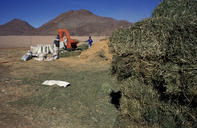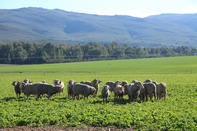
Storage in Co-operation Silos
After harvesting, farmers can store their grain at co-operation silos to sell cereal crops at a time when prices are better. The cost of storage and grain handling and interest lost because of later sales, might however not justify this option.
Storage in Own Silos

The grain can be stored in your own silos, but the high capital investment required to build a silo does not justify the cost for the majority of farmers when selling cereal crops.
Besides this, you will be personally liable to look and manage the grain in your silo, whereas specialists are employed to do so at co-operative silos.
Storage in Silo Bags
Grain can be stored in silo bags, which are much cheaper than silos. Farmers should keep in mind, however, that the quality of grain will deteriorate over extended periods of time.Pre-harvest Forward Contracts
A forward contract is an agreement between two parties to buy or sell any kind of asset at a future point in time, usually at a set price.
The biggest benefit is that you have a secure market for your produce, but you will not share in favourable price movements and be liable to deliver the hedged quantity.
A farmer, in effect, might have to pay penalties or buy volumes in from other producers to make up for production shortfalls.
Use the Spot and Future Market
Farmers who do not want to store their grain, can sell it on the spot market after the harvest and then buy futures, to cash in on positive price movements, that may occur later. The risk of this is that market prices might decrease and then result in losses.Use Futures and Options
Farmers can hedge themselves against price fluctuations by trading on the Commodity Derivatives Market, called Safex. It is a common practice for farmers to hedge about a third of the grain before planting to cover their production costs and then hedge the rest later during the season based on price movements
The best is to settle for a “fair” price in relation to your cost of production per hectare. Waiting for prices to climb higher and higher can result in missed out opportunities.
It actually requires a lot of expertise to trade on this platform, since you really need to know what is happening in the world market. Farmers, for this reason, usually hire traders, which cost a fee, to trade on their behalf.
Animal Feed
